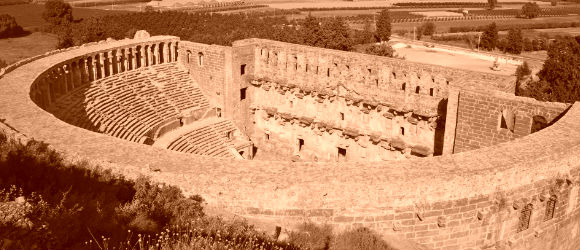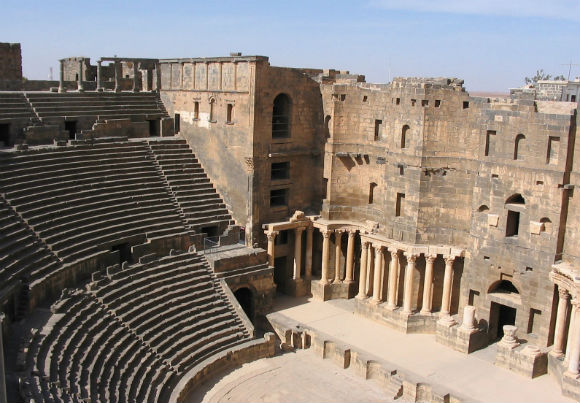Aspendos was an ancient Greco-Roman city in Antalya province of Turkey. It is located 7 kilometres (4.3 mi) northeast of central Serik.
Aspendos was an ancient city in Pamphylia, Asia Minor, located about 40 km east of the modern city of Antalya, Turkey. It was situated on the Eurymedon River about 16 km inland from the Mediterranean Sea; it shared a border with, and was hostile to, Side. According to later tradition, the (originally non-Greek) city was founded around 1000 BC by Greeks who may have come from Argos. The wide range of its coinage throughout the ancient world indicates that, in the 5th century BC, Aspendos had become the most important city in Pamphylia. At that time the Eurymedon River was navigable as far as Aspendos, and the city derived great wealth from a trade in salt, oil, and wool.
Aspendos did not play an important role in antiquity as a political force. Its political history during the colonization period corresponded to the currents of the Pamphylian region. Within this trend, after the colonial period, it remained for a time under Lycian hegemony. In 546 B.C. it came under Persian domination. The face that the city continued to mint coins in its own name, however, indicates that it had a great deal of freedom even under the Persians.
In 467 B.C. the statesman and military commander Cimon, and his fleet of 200 ships, destroyed the Persian navy based at the mouth of the river Eurymedon in a surprise attack. In order to crush to Persian land forces, he tricked the Persians by sending his best fighters to shore wearing the garments of the hostages he had seized earlier. When they saw these men, the Persians thought that they were compatriots freed by the enemy and arranged festivities in celebration. Taking advantage of this, Cimon landed and annihilated the Persians. Aspendos then became a member of the Attic-Delos Maritime league.
The Persians captured the city again in 411 B.C. and used it as a base. In 389 B.C. the commander of Athens, in an effort to regain some of the prestige that city had lost in the Peloponnesian Wars, anchored off the coast of Aspendos in an effort to secure its surrender. Hoping to avoid a new war, the people of Aspendos collected money among themselves and gave it to the commander, entreating him to retreat without causing any damage. Even though he took the money, he had his men trample all the crops in the fields. Enraged, the Aspendians stabbed and killed the Athenian commander in his tent.
When Alexander the Great marched into Aspendos in 333 B.C. after capturing Perge, the citizens sent envoys to him to request that he would not establish that he be given the taxes and horses that they had formerly paid as tribute to the Persian king. After reaching this agreement. Alexander went to Side, leaving a garrison there on the city’s surrender. Going back through Sillyon, he learned that the Aspendians had failed to ratify the agreement their envoys had proposed and were preparing to defend themselves. Alexander marched to the city immediately. When they saw Alexander returning with his troops, the Aspendians, who had retreated to their acropolis, again sent envoys to sue for peace. This time, however, they had to agree to very harsh terms; a Macedonian garrison would remain in the city and 100 gold talents as well as 4.000 horses would be given in tax annually.
In 190 BC the city surrendered to the Romans, who later pillaged it of its artistic treasures. Toward the end of the Roman period the city began a decline that continued throughout Byzantine times.
Aspendos,



I am surprized that no one has posted a review of this place so I would like to be the first to add my review. Yesterday we took a cultural family trip to visit the sites east of Antalya and after visiting Perge we continued to drive towards the ancient theater of Aspendos about 44 kms east of Antalya. It…
The car park is very large at this ancient site. It needs to be to accommodate the tourists buses and stalls. Concerts, including opera and ballet, are held here on a regular basis as well as in the new arena a kilometre away. Whilst we were there in late October, a Canadian and German group gave an impromptu performance and…
interesting but only for a short while. Very warm as it holds the sun and heat. Good architecture.
You will get hassled by their photographer and 2 gladiators who want you to pose for a pic and then buy off them as they get anti if you take their photo.
Toilets outside and they cost, along with drinks which are…
Went on a Thomas Cook trip and would recommend. Just astounding the work involved and it is best preserved Roman theatre. Would have loved to have gone to a production here because great venue.
Def a great stop w/in easy distance from Antalya. Other than the fake gladiators, we were so impressed. Great restoration project, thank god the Turks never destroyed it. We were on a tour so have no idea how much they charge for entrance.I will gladly pay 1tl for a spotless WC with a western toilet!!you don't need a heap of…
Sitting around 40 minutes from Antalya, there's nothing around but this theatre, give it a try for 30 minutes, go in the morning to avoid peak hours in the afternoon!
We visited in March, on a cold and rainy day. It was pouring rain and lightning was lighting up the sky, and it was amazing. All that really didn't matter, once you walk through the gate, down the tunnel and emerge on the floor of the theater you were instantly blown away.
The 7,000 seat (i believe) theater is amazing…
Visited in November 2012. Fine example of well preserved Roman architecture. Not overcommercialised and good information available on site
Unfortunately when we visited Aspendos it was August, so very very hot.
Great theatre to look round and very well preserved.
Went here as part of a tour. Charge is 15tl for adults, children under 12 are free. It was spectacular and well worth the visit. Be warned it is extremely hot. Take water! There is also a church to visit and a hill you can go up to get an arial view. The walk to the church and to go…